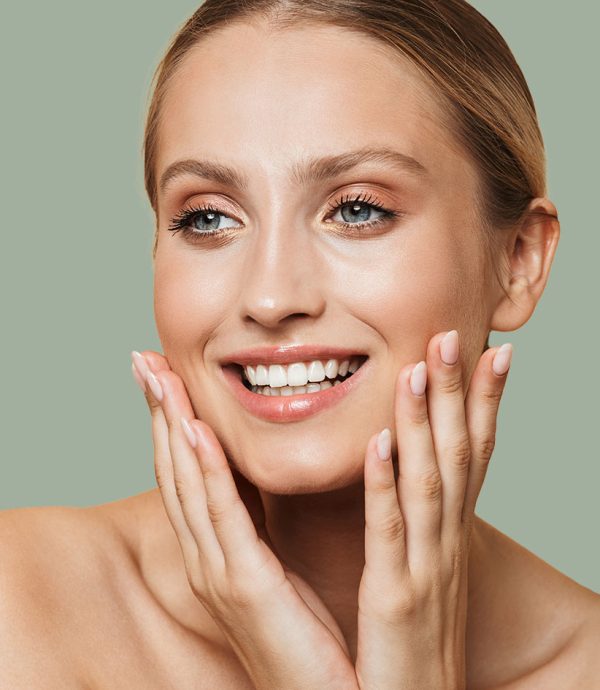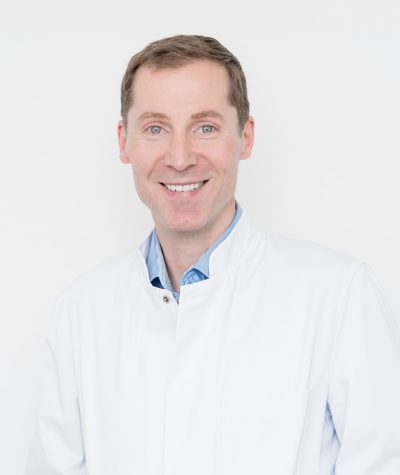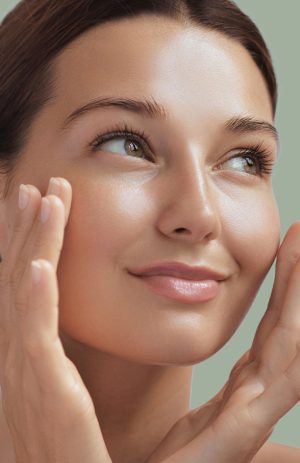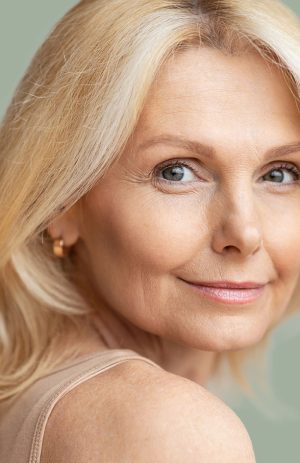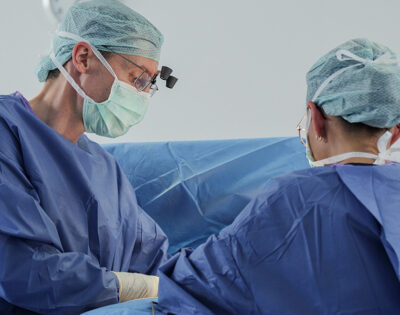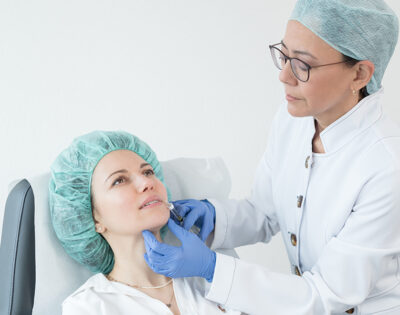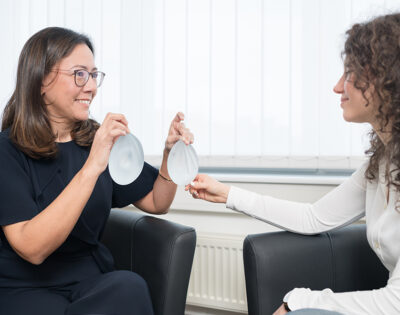The cheek structure: High cheekbones as a beauty ideal
You can argue about beauty, but not about attractiveness. A review of 1800 scientific studies shows that there is strong agreement both within and between cultures about who is attractive and who is not 1 . The attractiveness or beauty ideal of the face not only determines our first impression of strangers, but also who we talk to, who we get to know and who we pay attention to. The following features are generally perceived as attractive:
- Symmetry
- proportions, which are particularly widespread among young people, and
- Proportions that are characteristic of a man or woman 2
When looking at a face from the side or in half profile, a person’s gaze intuitively falls first on the cheekbones 3 . Are you dissatisfied with your profile or semi-profile? Are you still not achieving the desired results with contouring? Do you want the cheekbones of the stars and starlets?
You can expect the following with cheek augmentation with hyaluronic acid:
- Rejuvenate your appearance
- Pleasing yourself again
- Increase attractiveness with a youthful center of the face
- Professional advice
What our patients say
Information at a glance
Duration of treatment
30 minutes
Aftercare
none
Anesthesia
Anesthetic cream / vibration anesthesia / local anesthesia
Thread tension
no
Hospitalization
Outpatient
Socially acceptable
immediately
Costs
Additions or alternatives
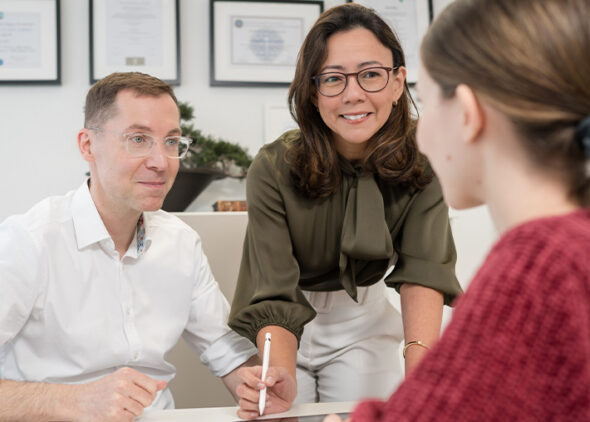
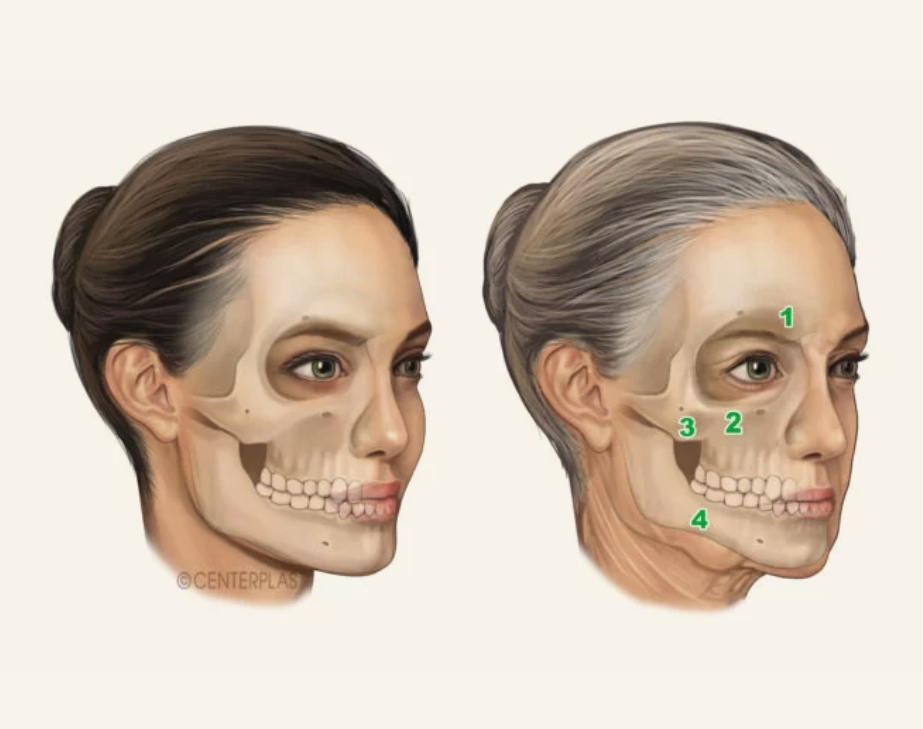
Why cheek augmentation?
To enhance the impression of high cheekbones, light-shadow effects are often created with make-up. Proportions often determine whether a facial feature is attractive or not. With symmetry, the cheekbone on one side is set in relation to the other side. A width ratio of the lower jaw in relation to the cheekbone of 75 percent is perceived as particularly attractive in women 19 . High, prominent cheekbones in relation to the lower half of the face are considered attractive in both men and women. However, high cheeks have a greater effect on the attractiveness of women’s faces 20 . A ratio of the distance between the cheekbones and the chin and the distance between the corner of the eye and the chin of 80 percent looks attractive 21 . Based on scientific findings, an aesthetic treatment emphasizes individual features to give the face more expressiveness. In the hands of experienced specialists and in consideration of harmonious proportions, 94 percent of patients are satisfied with hyaluronic acid cheekbone injections 22 .
Cheek augmentation for a round face? Your options
Chubby cheeks and a double chin disguise the contours of the cheeks. Beautiful cheeks are created by a gently curved transition from the cheekbones to the lower jaw and give the face a youthful appearance. The curved contour is best emphasized in the half-profile view. The S-curve of youthful high cheeks is referred to as the “ogee curve” in American parlance. There are various approaches to emphasizing the expressiveness of a round face and realizing the desire for defined, fresh and youthful facial contours. A hyaluronic acid treatment can enhance the lateral cheekbones and chin and tighten the skin. The appearance is improved as desired and natural facial expressions are retained. The injection of a muscle relaxant into the chewing muscle also helps to achieve a slimmer shape. The combination makes it possible to harmonize the desired result of cheek augmentation across the entire face. In addition, the eyebrows can be slightly lifted with a muscle-relaxing substance. A fat removal injection can correct a double chin or sagging cheeks.
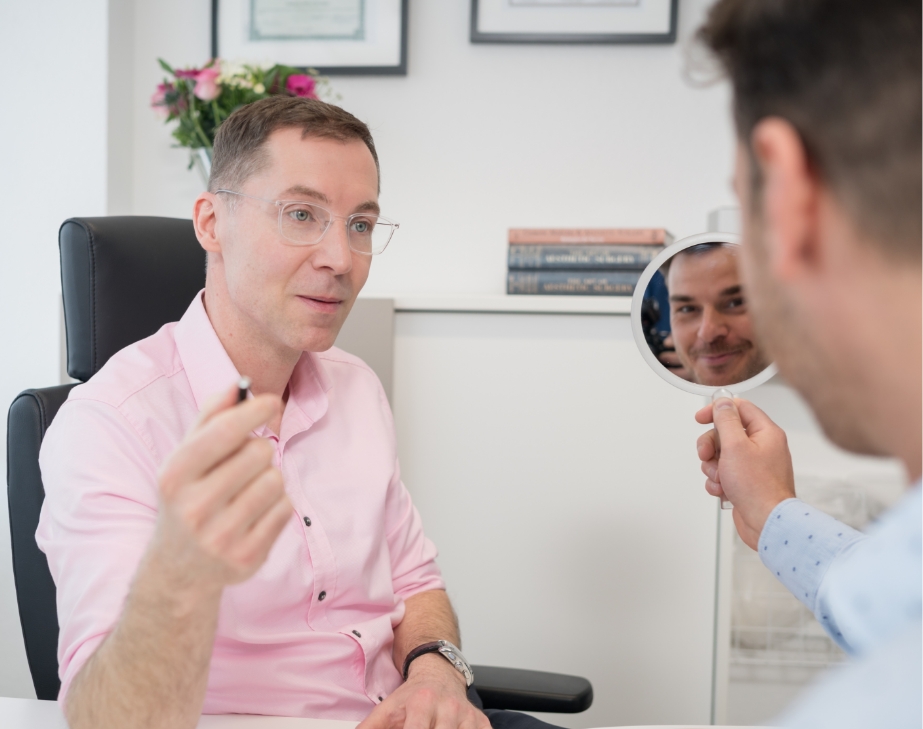
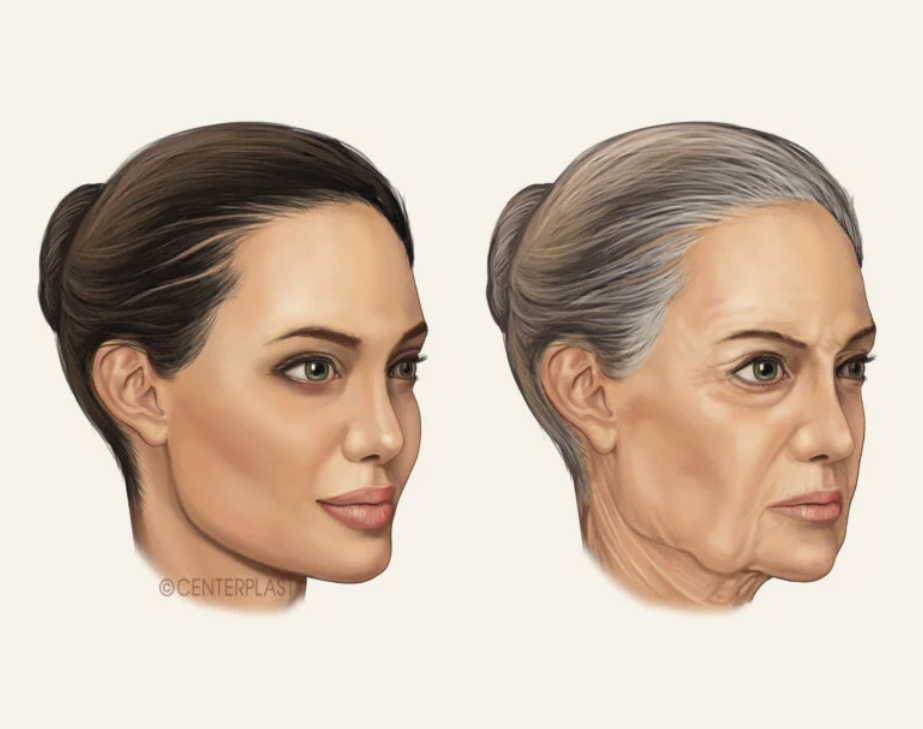
How does the face change with age?
Age-related changes to the face, such as the so-called hollow cheeks, increase from the age of thirty. Genetic predisposition and lifestyle habits such as cigarette smoking and frequent sunbathing (UV radiation) can accelerate these processes and increase volume loss. On the other hand, it has less to do with severe weight loss. With increasing age, more precisely between the ages of twenty-five and forty-five, women experience bone loss, which also affects the cheekbones. The hollow cheeks are also caused by age-related sagging of the connective tissue: the fat pads on the cheeks slip down. The fatty tissue recedes, making the sunken cheeks appear even more pronounced. The facial muscles are stretched and the range of movement of the muscles decreases with age. The change in the skin leads to sagging and the formation of wrinkles.
All these changes cause the formation of wrinkles between the nose and the corners of the mouth (nasolabial folds) and wrinkles between the corners of the mouth and the lower jaw (marionette lines) as well as dark circles under the eyes. The facial expression may appear tired or sad, even though the person concerned does not feel exhausted or sad. The aim of hyaluronic acid treatment is to bring the facial expression back into harmony with the state of mind. A holistic treatment of the sagging contours with this active ingredient makes sense.
What is the Liquid-Lift?
Studies show that the deep fat pads of the face in particular lose volume with age 4 . As a result, the skin and superficial tissue sag. In certain places, the skin is anchored to facial muscles or the bone and can therefore hardly sag. As the surrounding tissue slackens with age, furrows tend to form at the attachment points.
Mid-cheek creases occur at a connective tissue anchorage between the skin and cheekbone (“zygomatic cutaneous ligament”). Dark circles form at the attachment point of a ligament between the skin and the orbital rim (“orbitomalar ligament”, “orbicularis retaining ligament”, “arcus marginalis”).
At the nasolabial fold, the skin is connected to several muscles of the mouth. Hyaluronic acid treatment replaces the lost volume of sunken cheeks. Restoring volume gives the cheeks more beautiful contours. Precise injections above or below the facial muscles can improve the transmission of muscle strength.
The injection restores harmonious, youthful contours and improves the natural expressiveness of the face. The volume build-up creates a certain tightening effect by softening the wrinkles between the nostrils and the corners of the mouth (nasolabial folds). The injection of a relatively small amount of hyaluronic acid already leads to a lifting effect with correction of dark circles under the eyes and reduction of the nasolabial fold and sagging cheeks. The results are immediately visible. Nevertheless, filler treatments cannot be compared with a facelift.
Cheek augmentation with hyaluronic acid can significantly rejuvenate the face and delay the need for surgery. A facelift to rejuvenate the lower half of the face is much more effective for significantly sagging skin. For a natural and satisfying liquid lift, the treatment must be appropriate and holistic. Proportionality to other areas of the face such as the temples, forehead or cheek contours should be maintained with hyaluronic acid injections.
The special features of the cheek structure in men
The contour and fullness of the cheeks show particular, characteristic differences in men and women. In men, the cheeks, especially the frontal process and the temporal bone process of the cheekbone, are stronger 5 . A prominent chin and jawline, pronounced cheekbones and narrow cheeks develop under the influence of male hormones between the ages of 12 and 15 6 . In men, the cheeks are less prominent in the middle area than in women 7 . Male facial features are often associated with dominance and social competence 8 . In fact, there is evidence that people with very masculine facial features have more muscle strength 9 . It is therefore not surprising that women find men with pronounced cheekbones more attractive 10 .
The cheek is a common problem area in men. Due to congenital factors, the zygomatic arch can lack contours in relation to the jaw-chin line or the eyebrows, which means that men also have to contend with the problem of sunken cheeks. In men, the facial bones deteriorate between the ages of forty-five and sixty-five. Although a beard can conceal the chin and jawline, the outline of the cheeks tends to be emphasized by a beard hairstyle. Cheek injections can be used to emphasize masculine facial features or to build up youthful cheeks. Overcorrection, especially injecting too much volume in the midsection, leads to full cheeks and makes a face appear feminine. It is therefore advisable to consult an experienced doctor to sharpen the cheek contours precisely.
Procedure of a cheek build-up

Preparation
Our aim is to emphasize the facial features that give your face an individual touch of beauty or specialness. Features that appear unattractive, such as sunken cheeks, can be reduced with a hyaluronic acid treatment. For a balanced result, your facial contours are examined and a treatment plan tailored to you is designed. Many patients request an injection immediately after the consultation.
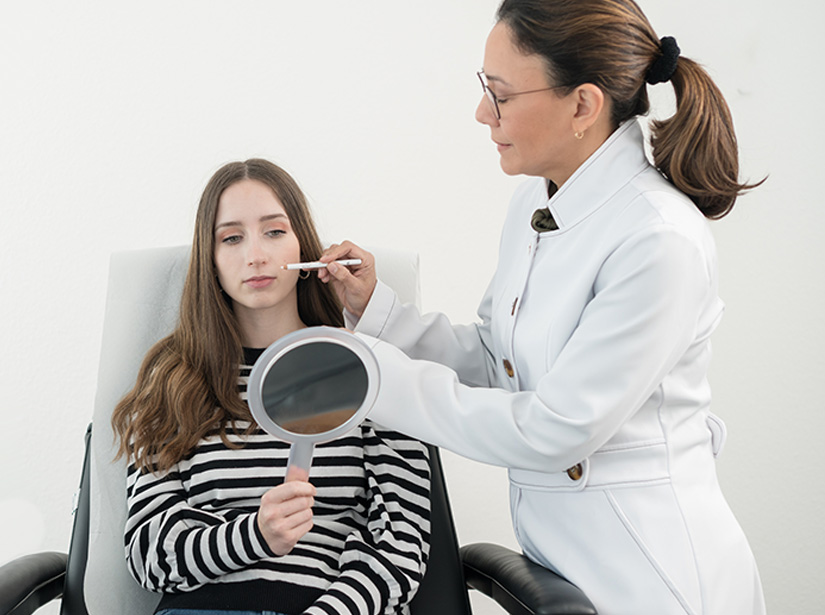
The treatment
After all your questions have been answered, an anesthetic cream will first be applied for your comfort. The skin is then thoroughly cleaned and disinfected with alcohol. A concentrated hyaluronic acid is infiltrated near the cheekbone. Slightly smoother fillers are more suitable for building up superficial fat deposits. This results in a more harmonious distribution of hyaluronic acid and an improvement in the moisture content and surface structure.
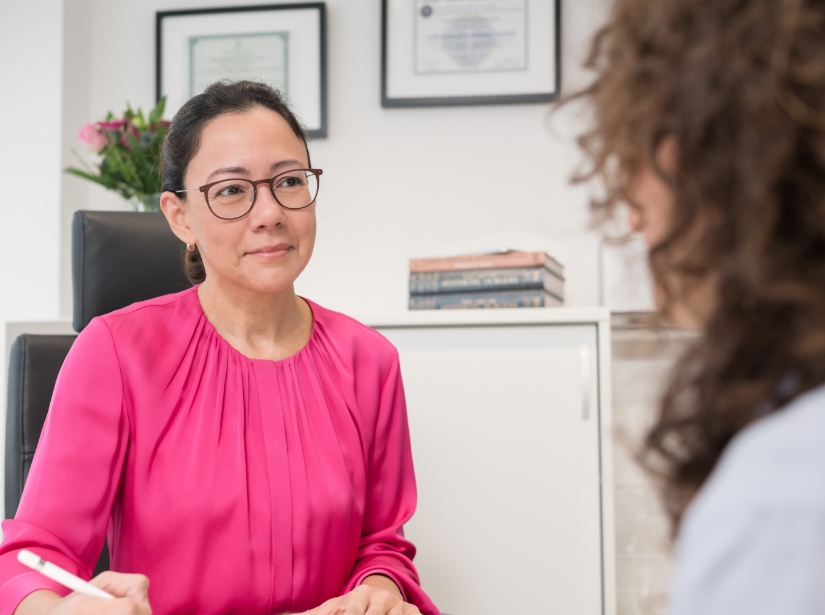
After the treatment
Superficial injections stimulate the connective tissue cells (fibroblasts) and increase the formation of elastin and collagen in the tissue. You can use cooling pads to prevent swelling or redness immediately after the injection. After the treatment, you will receive a filler passport in which the trade name and batch number of the hyaluronic acid are documented. To ensure an optimal result, we will give you a few recommendations on how to proceed. You will be given a telephone number so that you can contact your doctor at any time in case of doubt. We offer our patients an appointment about two weeks after the injection to make sure they are satisfied.
How long does cheek augmentation with hyaluronic acid last?
The effect of cheek injections is immediate and therefore visible very quickly. The effect lasts for over a year. After 6 months, 90 percent of patients are satisfied with the results of cheek injections 11 . Studies show that over 70 percent of patients are still satisfied with the result after one year 12 .
According to our many years of experience, less hyaluronic acid is required for a further treatment in the frame (follow-up injection) than for the initial treatment, even after 18 months. Of course, this depends on your personal metabolism. For long-lasting results, we recommend microfat injections. The autologous fat is considered a permanent filler. Since the so-called lipofilling method uses the body’s own substance, which is suctioned from the abdomen, for example, an allergic reaction is ruled out.
Risks associated with cheek injections
No treatment is completely without risks. However, the risks of cheek augmentation with hyaluronic acid are generally low and the slight possible side effects are only temporary. Some swelling and minimal reddening of the skin may also occur when using very fine needles. Gentle cooling helps to prevent swelling from occurring in the first place or helps it to subside again after a short time, within a few hours to be precise. Allergic reactions and inflammation are among the very unlikely risks. Unfortunately, it can never be completely ruled out that a small vessel will be damaged during the injection.
In rare cases, hyaluronic acid can enter the bloodstream. Even more rarely, the hyaluronic acid interrupts the blood flow and jeopardizes the blood circulation of the skin, causing small bruises to form. The experienced doctors at CenterPlast are of course prepared for rare occurrences. Such complications can be controlled by recognizing them early and taking the necessary measures immediately 13 .
The most common undesirable effect of hyaluronic acid cheek injections is unsatisfactory results, especially if the user does not have the necessary experience and qualifications. Injections by unqualified practitioners without a license to practice medicine and without precise knowledge of anatomy are dangerous.
Hyaluronic acid or thread lifting? This treatment suits you
The cheeks already lose volume between the ages of 30 and 40 14 . The changes are due to bone remodeling as well as a loss of fatty tissue and a loss of skin elasticity. The sagging of the tissue causes wrinkles to develop between the nose and the corners of the mouth. Hyaluronic acid restores the volume of the cheeks without surgery. As a result, the skin lifts and the nasolabial fold disappears. This technique is therefore also known as a liquid facelift and was described by the Brazilian plastic surgeon Maracio de Maio in 2010. The thread lift counteracts the force of gravity and returns the fat deposits to their original position.
So much for the theory, but which treatment is more effective? A comparative study suggests that both treatments are very safe but that patient satisfaction is higher after filler treatment 15 . Satisfaction is particularly high with a combination of fillers and absorbable sutures 16 .
Filler or autologous fat for cheek augmentation?
In principle, two tissue fillers can be used for cheek injections for sunken cheeks: Hyaluronic acid and autologous fat. In fact, there are studies that compare the methods. They came to the conclusion that both methods are safe and that more volume is retained after one year following an autologous fat injection 17 . The autologous fat treatment has many advantages. This also applies to other areas of the face, such as around the eyes or on the lips. Breast augmentation with autologous fat also promises excellent, very satisfactory and, above all, natural and long-lasting results.
In principle, autologous fat treatment can be performed on healthy patients at any time, regardless of body weight. The fatty tissue can be suctioned from the abdomen, hips, inner thighs or knees. The fat cells are then processed in a separation process, filtered and injected at the desired location. As with all procedures involving living cells, autologous fat treatment also has a certain loss rate. A certain percentage of cells may die during removal and processing or be broken down by the body during healing. This percentage varies depending on the patient’s age, state of health and lifestyle, as well as the behavioral measures taken after the injection.
We have optimized the techniques for harvesting, preparing and injecting the cells so that around 70 percent of the cells grow permanently. Compared to hyaluronic acid, autologous fat is suitable for compensating for a larger volume, for example for simultaneous treatment of the chin-jaw contour, lower eyelids, lips, nose, forehead, temples and earlobes. The autologous fat treatment also improves skin quality 18 .
Our experience reports on cheek augmentation with filler
Before patients decide to undergo cheek augmentation and choose a suitable experienced expert for the treatment, they usually search the internet for filler experience reports. People who have already undergone injections at the practice in question explain in such reports whether they were satisfied with the service, the consultation and, of course, with the treatment and the final result. If you would like to find out more, visit our experience section.
Before and after pictures of cheek augmentation with filler
Before patients decide on a cheek augmentation, they often want to see before and after photos of such a filler treatment so that they can visualize how the cheeks were filled in this practice. CenterPlast also offers the opportunity to see before and after results during a preliminary consultation. We would be happy to present these to you in a personal consultation.
Frequently asked questions
A harmonious and natural result is our priority. The question of how large the amount of product needs to be in order to optimally reduce the sunken cheeks with a cheek injection varies from person to person. To do this, the specialist and expert in aesthetic medicine must examine exactly what volume is required to make the cheeks, jawline (jawline), lips and forehead look balanced, i.e. harmonious with each other and attractive as a whole.
Always using the same volume in the same place leads to stereotypical faces and does not meet the high demands of our patients or our practice. Treatment of the cheeks restores contours that have been lost due to the loss of fatty tissue. These changes are age- and gender-dependent.
The amount of product, location and depth of injection must be carefully determined based on a thorough knowledge of the anatomy. It is essential to examine the contours and facial expressions before every treatment. Good cohesion (cohesiveness) of the gel is important so that the hyaluronic acid does not slip under the influence of the facial muscles. Fillers with a high modulus of elasticity, i.e. somewhat firmer gels, are very suitable for filling the cheekbones.
More fluid gels are used for superficial treatment. Depending on the findings, 2 to 4 milliliters of hyaluronic acid are required for a 3-dimensional contouring. It is not only the quantity and quality of hyaluronic acid that is important for an optimal result. Make sure that your doctor is experienced in the selection and application of treatment techniques. Only an aesthetic plastic surgeon has the combination of experience and this specific knowledge of the anatomy and the appropriate measures with the most suitable amount and technique of cheek augmentation with hyaluronic acid.
An autologous fat treatment or hyaluronic acid injections are suitable for cheek augmentation. If the cheeks are particularly sunken, i.e. there is also significant sagging of the connective tissue and skin, a midface lift should be considered. This minor operation, also known as cheek correction, is used to treat bags under the eyes, dark circles or to combat swelling above the cheekbone (“festoons”, “malar mounds”, “malar bags”). Lacrimal sacs develop above the bony rim of the eye socket due to sagging of the connective tissue ligament. Dark circles form below the bone edge of the eye socket due to sagging of the skin and atrophy of the fatty tissue (“tear trough”).
A hyaluronic pen is a device that injects a liquid through the skin at high pressure (0.5 bar to 17 bar). The liquid jet can be generated by different mechanisms:
- Spring-operated injectors, such as the Dermojet from AKRA in France.
- Pneumatic injection devices driven by an air compressor, such as EnerJet from PerfAction Technologies, Israel or Med-Jet from Medical International Technologies, Canada.
The advantages of injecting with a high-pressure gun are
- The small diameter of the beam of less than 0.2 millimeters.
- The high injection speed of around 30 milliseconds 23 .
The disadvantages of a high-pressure gun are:
- Only very liquid substances can be injected.
- A maximum volume of 0.3 milliliters can be administered per injection.
- Only superficial penetration is possible.
Immediately after penetrating the skin, the liquid jet is broken down into fine droplets and dispersed into the tissue in an untargeted manner. Hyaluronic acid pens are not as harmless as the name suggests. Experienced plastic surgeons know the distribution pattern of fluids in the tissue, as injuries caused by high-pressure spray guns are rare but dangerous injuries. Hyaluronic acid pens are completely unsuitable for treating the cheeks, as larger quantities of firmer hyaluronic acid must be injected deeply and specifically into the tissue by a specialist. Nevertheless, hyaluronic acid pens are widely used because, unlike hyaluronic acid injections, their use is not yet regulated by law. An aesthetic treatment is a medical treatment. We therefore recommend that you consult doctors who have a comprehensive knowledge of anatomy, hygiene and pharmacology. Make sure that they are always experienced experts in aesthetic and plastic surgery.
This is a minimally invasive treatment. At the beginning of the hyaluronic acid treatment, the face is thoroughly disinfected. A local anesthetic cream is then applied so that no pain is felt when the high-quality hyaluronic acid is carefully and precisely injected by the cosmetic surgery specialist. CenterPlast also offers other options to ensure that you feel completely comfortable and relaxed during the hyaluronic acid injection.
In order to be personally advised by the attending physician and to find out about a possible course of treatment in your individual case, you should make an appointment for a personal consultation. This is an important component when it comes to cheek injections. As part of a corresponding examination, the exact requirements (personal requirements) and the individual risks are checked and the exact scope of the treatment is discussed. A comprehensive preliminary examination is always essential for patients.
Before cheek augmentation with filler, an examination and the preparation of a treatment plan are essential. The cost of the service is calculated on the basis of the amount of hyaluronic acid injected. CenterPlast offers fair prices. We will also be happy to provide you with information on the options for financing interventions.

AUTHOR
Dr. Adelana Santos Stahl
Our aim is to offer optimal, discreet and precise treatment based on our extensive expertise in the field of plastic surgery.
Dr. Adelana Santos Stahl has a unique international perspective with a female view of plastic surgery. Your individual and detailed approach is the key to the beautiful and natural results. Having trained in Brazil, one of the largest and best-known countries for aesthetic and reconstructive plastic surgery, she understands her patients’ desire to look and feel their best.
She completed her medical studies and training as a specialist in plastic and aesthetic surgery in Brazil. In 2009, she also successfully passed the German equivalence examinations for the state medical examination.
Two years later, in 2011, she received the German and in 2012 the EU specialist certification (EBOPRAS) for plastic surgery. From 2009 to 2013, she deepened her knowledge of aesthetic and reconstructive facial surgery with world-renowned representatives of plastic surgery such as Professor Gubisch at the Marienhospital and Madame Firmin in Paris.
A VDÄPC Fellowship (continuing scholarship for graduate students) in Switzerland, France and the USA has further enriched her professional experience. Dr. Santos Stahl is active in various renowned professional associations. In addition to the DGPRÄC and DGBT, she is also a member of the Brazilian Society of Plastic Surgery – SBCP.
She is also the author of several scientific articles and, together with her husband, is dedicated to research and clinical studies in the field of plastic surgery.
She has been based in Saarbrücken since 2019.
- Langlois JH, et al., 2000, Psychol Bull ↩︎
- Perrett D.I., et al., 1988, Nature ↩︎
- Saether L., et al., 2009, Vision Res ↩︎
- Wu TY, et al., 2020, J Chin Med Assoc ↩︎
- Woo H.K., 2020, Head Face Med ↩︎
- Kaptein Y.E., et al., 2015, Plast Reconstr Surg Glob Open ↩︎
- Li D, et al., 2017, Plast Reconstr Surg ↩︎
- Rohrich RJ, et al., 2008, Plast Reconstr Surg. ↩︎
- Gonzalez PN, et al., 2011, Int J Osteoarchaeol ↩︎
- Koudelová J, et al., 2015, Orthod Craniofac Res. ↩︎
- Mydlová M, et al., 2015, Forensic Sci Int. ↩︎
- Keating C.E., et al., 1981, Ethology and Sociobiology ↩︎
- Windhager S., et al., 2011, Am J Hum Biol. ↩︎
- Cunningham M.R., et al., 1990, J Pers Soc Psychol. ↩︎
- Julius F, et al., 2015, Aesthet Surg J ↩︎
- Huh CH, et al., 2020, Plast Reconstr Surg Glob Open. ↩︎
- Ors S., 2020, Aesthetic Plast Surg ↩︎
- Wysong A, et al., 2013, Dermatol Surg. ↩︎
- El-Mesidy M.S., et al., 2020, Arch Dermatol Res. ↩︎
- Ali Y.H., 2018, J Cosmet Laser Ther ↩︎
- Pascali M, et al., 2017, J Biol Regul Homeost Agents; Hu X., et al., 2017, J Cosmet Dermatol ↩︎
- Yin Y, et al., 2020, J Plast Reconstr Aesthet Surg. ↩︎
- Vinshtok Y, et al., 2020, J Cosmet Dermatol. ↩︎
You might also be interested in
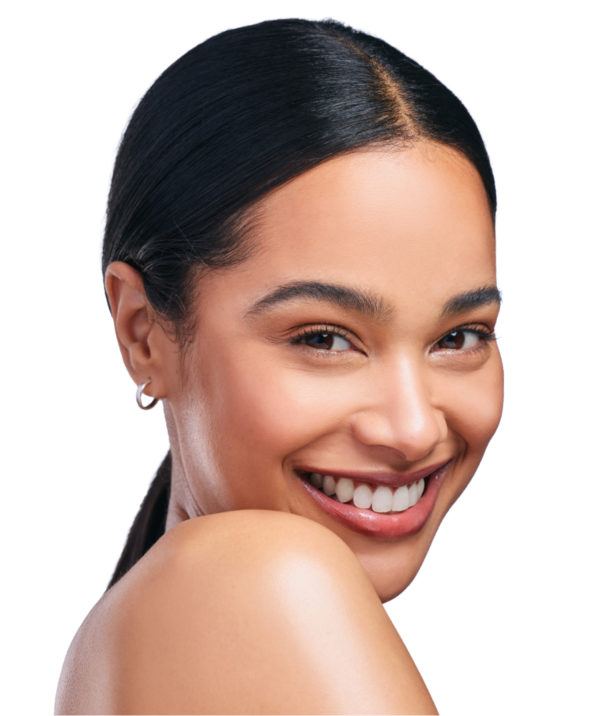
Personal advice
We take time for you and offer you customized advice and treatment for your individual result.
